Shoot 'em ups are a sub-genre of action games. There is no consensus as to which design elements compose a shoot 'em up; some restrict the definition to games featuring spacecraft and certain types of character movement, while others allow a broader definition including characters on foot and a variety of perspectives.
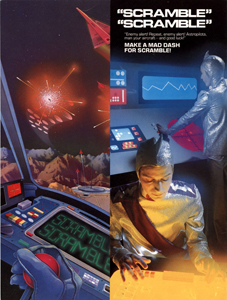
Scramble is a horizontally scrolling shooter arcade video game released in 1981. It was developed by Konami and manufactured and distributed by Leijac in Japan and Stern in North America. It was the first side-scrolling shooter with forced scrolling and multiple distinct levels, and it established the foundation for a new genre.
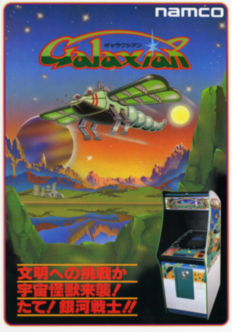
Galaxian is a 1979 fixed shooter arcade video game developed and published by Namco. The player assumes control of the Galaxip starfighter in its mission to protect Earth from waves of aliens. Gameplay involves destroying each formation of aliens, who dive down towards the player in an attempt to hit them.

Xevious is a vertically scrolling shooter arcade video game developed and published by Namco in 1982. It was released in Japan by Namco and in North America by Atari, Inc. Controlling the Solvalou starship, the player attacks Xevious forces before they destroy all of mankind. The Solvalou has two weapons at its disposal: a zapper to destroy flying craft, and a blaster to bomb ground installations and enemies. It runs on the Namco Galaga arcade system.
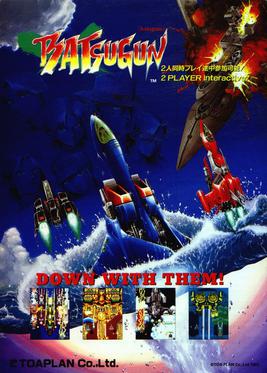
Batsugun is a 1993 vertically scrolling bullet hell arcade video game originally developed and published by Toaplan in Japan and Europe by Taito, as well as Korea by Unite Trading. The last shoot 'em up created by Toaplan, the title takes place on a distant Earth-like planet where a global takeover operative led by king Renoselva A. Gladebaran VII is set into motion, as players assume the role from one of the six fighter pilots conforming the Skull Hornets squadron taking control of submersible jets in a last-ditch effort to overthrow the invading military force from the planet. Its gameplay mainly consists of shooting mixed with role-playing game-esque elements using a main two-button configuration.
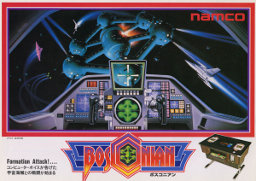
Bosconian is a scrolling multidirectional shooter arcade video game developed and released by Namco in Japan in 1981. In North America, it was manufactured and distributed by Midway Games. The goal is to earn as many points as possible by destroying enemy missiles and bases using a ship which shoots simultaneously both the front and back.
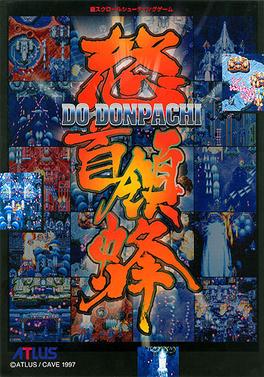
DoDonPachi is a vertically-scrolling bullet hell shoot' em up developed by Cave and published by Atlus in 1997. It was the second game developed by Cave, and the sixth on Cave's first-generation arcade hardware. As with its predecessor DonPachi, the title is both a Japanese term for expressing the sound of gunfire, and a term that relates to bees. The sequel to this game is DoDonPachi II, which was made by a different developer. The original developer later released its own sequel, DoDonPachi DaiOuJou.

Twinkle Star Sprites is a competitive vertically scrolling shooter arcade video game created by ADK and published by SNK in 1996. It was ADK's last production for the Neo Geo. Two players are each in separate, side-by-side, vertically scrolling levels. Combinations of shots and timed power-ups damage the other player. These attacks also serve as counters to the opponent's attack.

Progear is a 2001 horizontally scrolling bullet hell arcade video game developed by CAVE and published by Capcom for the CP System II board. Set in the fictional kingdom of Parts, players assume the role of children controlling a plane equipped with the titular propelling engine to overthrow the Metoruin sages and their new world order. It was the sixth shoot 'em up game from CAVE, their first horizontally oriented shooter, and their eighth video game overall.

R-Type Leo is a 1992 horizontal-scrolling shooter arcade game developed by Nanao and published by Irem. It is a spin-off of the R-Type series and the last R-Type entry to be released in arcades. In Leo, players take control of the titular space fighter to travel the man-made mechanical planet Eden and destroy its supercomputer core Major. The game was initially conceived as an original shoot 'em up by Nanao before being retooled into an R-Type project by Irem. The title was met with positive reception from reviewers. It has since been re-released as part of Dotemu's 2010 Irem Arcade Hits compilation.
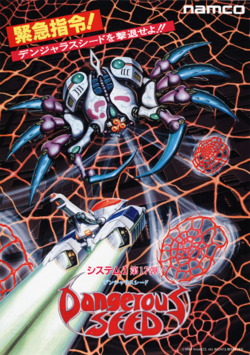
Dangerous Seed is a 1989 vertically scrolling shooter arcade game developed and published by Namco. Controlling one of three different starships, the player is tasked with destroying an alien race known as the Danger Seed before they wipe out all of mankind. Each ship has their own set of weapons and abilities, such as shots that dissolve enemies and target-seeking projectiles, and can sustain multiple hits before being destroyed. The player's ships can also combine into a new ship, the Moon Diver, featuring a stronger shield and additional weapons. It ran on the Namco System 1 hardware.

Puzzle Uo Poko is an arcade puzzle game developed by Cave and distributed by Jaleco.
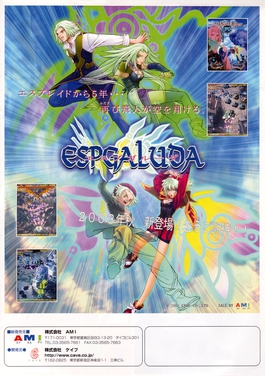
Espgaluda is a 2003 manic shooter by Cave and published by AMI. It is the spiritual successor to ESP Ra.De. and is followed by Espgaluda II.

G-Darius is a horizontally scrolling shooter arcade video game released by Taito in 1997. It is the fourth arcade installment of the Darius series and the first with three-dimensional polygonal graphics. A port to the PlayStation was published as G Darius.

NebulasRay is a vertical-scrolling shooter arcade game developed and released by Namco in 1994. Players take control of a starship named the Fighting Ray through a series of levels in its mission to eradicate the universe of an intergalactic organization named the Master Force. It is noteworthy for its usage of pre-rendering, where 3D models are converted into 2D sprites, creating the illusion of a 3D world.

Halley's Comet is an arcade video game created by Pacific Manufacturing Ltd and manufactured by its parent company Taito. Receiving a worldwide release in 1986, Halley's Comet is a vertically scrolling shooter where the player defends various planets around the Solar System from a direct collision with Halley's Comet and the various alien swarms which accompany it.

Gekirindan is a 1995 vertically scrolling shooter arcade video game originally developed and published by Taito in Japan, America and Europe. Set in the year 3195, where a robot known as "Huge Boss" stole a newly developed time machine to travel back in time and rewrite human history, players assume the role of one of the six fighter pilots taking control of their own space fighter craft in an effort to overthrow the evil entity from altering history.

Galaga '91 is a 1991 fixed shooter video game developed and published by Namco for the Game Gear. It was published by Sega in Europe and renamed Galaga 2. The first portable installment in the Galaxian series, players control a lone starfighter in its mission to eradicate the hostile Galaga forces before they take over Earth. Gameplay revolves around shooting down formations of enemies and avoiding their projectiles.

Final Blaster is a 1990 vertically scrolling shooter developed by Nova and published by Namco for the PC-Engine. Controlling the Blaster Mark II "Phoenix" starfighter, the player is tasked with wiping out the Bosconian alien race before they destroy Earth. Gameplay involves shooting down enemies and avoiding projectiles — power-ups can be collected to increase the player's abilities. It is the third and final game in Namco's Bosconian series.

ESP Ra.De. is a 1998 vertical-scrolling bullet hell arcade game originally developed by Cave and co-published by Atlus and Nihon System in Japan. Set in the year 2018, players assume the role from one of the three ESPers to overthrow Lady Garra and her Yaska syndicate from taking over Tokyo.




















